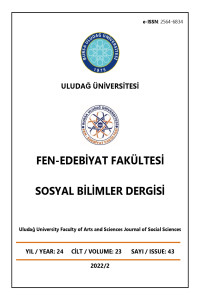Research Article
Decorations of The Dîvân-ı İlhâmî Copy Registered with T. 5526, İstanbul University Library of Rare Works
Abstract
After the military defeats against the European States at the end of the XVII century, the Ottoman Empire began to systematize its relations with the West from the beginning of the XVIII century. “Westernization” movements were carried out more consciously during the reign of Sultan Selim III (1789-1807), especially the traces of the innovations made in the military field have become prominent in culture and art as well as in the social and political field. There were also different applications in the art of book illumination, which had its share of innovations. As a result of the combination of baroque and rococo styles with Turkish taste, works in the style called “Turkish rococo” were produced. However, the classical rules continued to be applied despite the losses in motifs, patterns and techniques. The manuscript that is the subject of this article is the Dîvân-ı İlhâmî copy registered at Istanbul University Rare Works Library T. 5526. Imprint information of the Divan, which is one of the works in the classical style, whose decorations were made meticulously according to its period, is given, and its decorated pages are explained in detail by analyzing the pattern.
References
- Ayan Birol, İ. (2012). Tezhip. İslam Ansiklopedisi içinde (61-62. ss.), 41, TDV Yayınları.
- Ayverdi, İ. (2010). Perdaht. Kubbealtı Lugatı Misalli Büyük Türkçe Sözlük içinde (987 ss.), Kubbealtı Neşriyatı.
- Cezar, M. (1971). Sanatta Batıya açılış ve Osman Hamdi. Erol Kerim Aksoy Kültür Eğitim Spor ve Sağlık Vakfı Yayınları.
- Dalbaş Karahan, E. (2017). Tezhip sanatında Sultan III. Selim Dönemi (1789-1807). (Yayınlanmamış sanatta yeterlik tezi). İstanbul: Marmara Üniversitesi Güzel Sanatlar Enstitüsü.
- Derman M. U. ile 17.06.2016 tarihli görüşmemizden alınan notlar.
- Derman, F. Ç. (2009). Tezhip sanatında kullanılan terimler, tabirler ve malzeme. A. R. Özcan (Ed.), Hat ve Tezhip Sanatı içinde (525-535. ss.), Kültür ve Turizm Bakanlığı Yayınları.
- Derman, F. Ç. (2012). Sultan III. Selim Devri tezyinatındaki Batı tesirleri. Osmanlı Dünyasında Kültürel Karşılaşmalar ve Sanatsal Yansımaları, Prof. Dr. Filiz Yenişehirlioğlu Onuruna Sempozyum içinde (93-98. ss.), Hacettepe Üniversitesi Edebiyat Fakültesi Sanat Tarihi Bölümü Yayınları.
- Derman, F. Ç. (2013). Osmanlı İstanbulu’nda bezeme sanatı. F. M. Emecen, E. S. Gürkan (Ed.), Osmanlı İstanbulu I içinde (495-509. ss.), 29 Mayıs Üniversitesi Yayınları.
- Derman, F. Ç. (2015). İstanbul’da tezhip sanatı. C. Yılmaz, M. A. Aydın (Ed.), Antik Çağ’dan XXI. Yüzyıla Büyük İstanbul Tarihi; Edebiyat Kültür ve Sanat içinde (358-383. ss.), İBB Kültür AŞ Yayınları.
- Duran, G. (2018). Osmanlı tezhip sanatında natüralist üslûpta çiçekler. Süleyman Demirel Üniversitesi Sosyal Bilimler Enstitüsü Dergisi, 2(31), 177-199.
- Elgin, N. (1959). Üçüncü Sultan Selim (İlhâmi). Yıldız Basımevi.
- Pakalın, M. Z. (2004). İğne perdahtı demiri. Osmanlı Tarih Deyimleri ve Terimleri Sözlüğü içinde (38 ss.), II, Milli Eğitim Bakanlığı Yayınları.
- Sultan Selîm-i Sâlis. Dîvân-ı İlhâmî, İstanbul Üniversitesi Nadir Eserler Kütüphânesi, no: T. 5526.
- Yaman, B. (2008). Osmanlı saray sanatkârları 18. yüzyılda Ehl-i Hıref. Tarih Vakfı Yurt Yayınları.
İSTANBUL ÜNİVERSİTESİ NADİR ESERLER KÜTÜPHANESİ T. 5526 NUMARADA KAYITLI DÎVÂN-I İLHÂMÎ NÜSHASI TEZHİBİ
Abstract
Osmanlı Devleti XVII. yüzyıl sonlarında Avrupa devletleri karşısında aldığı askerî yenilgiler sonrasında XVIII. yüzyıl başlarından itibaren Batı’yla ilişiklerini sistematik hâle getirmeye başlamıştır. “Batılılaşma” olarak adlandırılan hareketler Sultan III. Selim Dönemi’nde (1789-1807) daha bilinçli bir şekilde sürdürülmüş, özellikle askerî sahadaki yeniliklerin izleri, toplumsal ve siyasi alanda olduğu kadar kültür ve sanatta da seçilir olmuştur. Yeniliklerden nasibini alan tezhip sanatında da farklı uygulamalar yer bulmuştur. Barok ve rokoko üsluplarının Türk zevki ile birleşmesi neticesinde “Türk rokokosu” olarak adlandırılan üslupta eserler verilmiştir. Bununla beraber klasik kaideler motif, desen ve işçilikteki kayıplara rağmen uygulanmaya devam etmiştir. Bu makaleye konu olan el yazması eser, İstanbul Üniversitesi Nadir Eserler Kütüphânesi T. 5526 numarada kayıtlı Dîvân-ı İlhâmî nüshasıdır. Dönemine göre tezyinatı özenli bir şekilde yapılmış klasik usuldeki eserlerden olan yazma, bulunduğu kütüphanede sayfa sayfa incelenmiş, eb’adı, bezemeli sayfaları tespit edilmiştir. Nitel araştırma yönteminin kullanıldığı araştırmada eserin künye bilgileri verilmiş, bezemeli sayfaları desen analizi yapılarak ayrıntılı bir şekilde anlatılmıştır.
Keywords
Supporting Institution
Bursa Uludağ Üniversitesi
References
- Ayan Birol, İ. (2012). Tezhip. İslam Ansiklopedisi içinde (61-62. ss.), 41, TDV Yayınları.
- Ayverdi, İ. (2010). Perdaht. Kubbealtı Lugatı Misalli Büyük Türkçe Sözlük içinde (987 ss.), Kubbealtı Neşriyatı.
- Cezar, M. (1971). Sanatta Batıya açılış ve Osman Hamdi. Erol Kerim Aksoy Kültür Eğitim Spor ve Sağlık Vakfı Yayınları.
- Dalbaş Karahan, E. (2017). Tezhip sanatında Sultan III. Selim Dönemi (1789-1807). (Yayınlanmamış sanatta yeterlik tezi). İstanbul: Marmara Üniversitesi Güzel Sanatlar Enstitüsü.
- Derman M. U. ile 17.06.2016 tarihli görüşmemizden alınan notlar.
- Derman, F. Ç. (2009). Tezhip sanatında kullanılan terimler, tabirler ve malzeme. A. R. Özcan (Ed.), Hat ve Tezhip Sanatı içinde (525-535. ss.), Kültür ve Turizm Bakanlığı Yayınları.
- Derman, F. Ç. (2012). Sultan III. Selim Devri tezyinatındaki Batı tesirleri. Osmanlı Dünyasında Kültürel Karşılaşmalar ve Sanatsal Yansımaları, Prof. Dr. Filiz Yenişehirlioğlu Onuruna Sempozyum içinde (93-98. ss.), Hacettepe Üniversitesi Edebiyat Fakültesi Sanat Tarihi Bölümü Yayınları.
- Derman, F. Ç. (2013). Osmanlı İstanbulu’nda bezeme sanatı. F. M. Emecen, E. S. Gürkan (Ed.), Osmanlı İstanbulu I içinde (495-509. ss.), 29 Mayıs Üniversitesi Yayınları.
- Derman, F. Ç. (2015). İstanbul’da tezhip sanatı. C. Yılmaz, M. A. Aydın (Ed.), Antik Çağ’dan XXI. Yüzyıla Büyük İstanbul Tarihi; Edebiyat Kültür ve Sanat içinde (358-383. ss.), İBB Kültür AŞ Yayınları.
- Duran, G. (2018). Osmanlı tezhip sanatında natüralist üslûpta çiçekler. Süleyman Demirel Üniversitesi Sosyal Bilimler Enstitüsü Dergisi, 2(31), 177-199.
- Elgin, N. (1959). Üçüncü Sultan Selim (İlhâmi). Yıldız Basımevi.
- Pakalın, M. Z. (2004). İğne perdahtı demiri. Osmanlı Tarih Deyimleri ve Terimleri Sözlüğü içinde (38 ss.), II, Milli Eğitim Bakanlığı Yayınları.
- Sultan Selîm-i Sâlis. Dîvân-ı İlhâmî, İstanbul Üniversitesi Nadir Eserler Kütüphânesi, no: T. 5526.
- Yaman, B. (2008). Osmanlı saray sanatkârları 18. yüzyılda Ehl-i Hıref. Tarih Vakfı Yurt Yayınları.
There are 14 citations in total.
Details
| Primary Language | Turkish |
|---|---|
| Journal Section | Articles |
| Authors | |
| Publication Date | July 31, 2022 |
| Published in Issue | Year 2022 Volume: 23 Issue: 43 |

